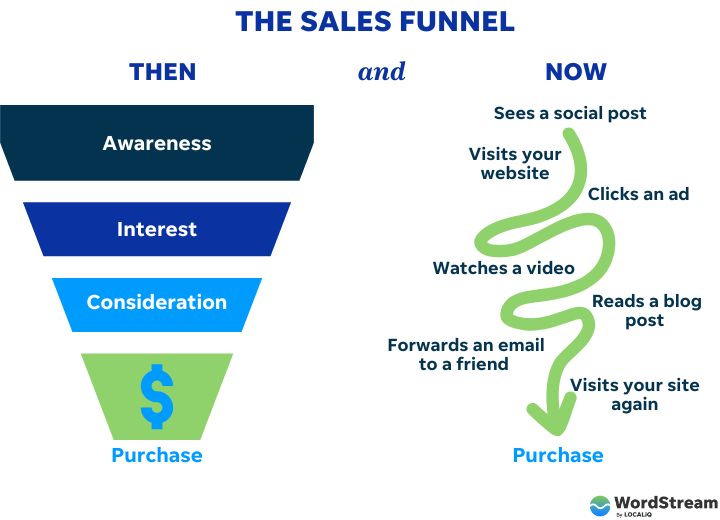Tracking qualified leads down the funnel from a single marketing channel is already a daunting task. Introduce a second channel into the mix, and you’re immediately raising the stakes.
That said, if your marketing campaign spans multiple channels, and you feel like manually tracking attribution is running you into the ground, you’re in the right place.
Thankfully, with the rise of marketing automation technology, artificial intelligence (AI), and machine learning, identifying customer touchpoints and behaviours is more convenient than ever.
In this guide, we’ll teach you how to connect your cross-channel marketing efforts to determine your true return on investment (ROI), plus tips on maximizing it.
TL;DR
What is cross-channel marketing attribution, and why is it important for businesses?
Cross-channel marketing attribution refers to the process of accurately assigning credit to the marketing touchpoints contributing to sales. It’s critical for businesses as it enables them to determine the most effective channels, optimize resource allocation, and refine their marketing strategies. With a comprehensive understanding of which channels are driving results, businesses can make informed decisions to maximize their return on investment.
How can businesses effectively track ROI across multiple marketing channels?
To effectively track ROI across multiple marketing channels, businesses should leverage a combination of marketing attribution models, advanced analytics platforms, and customer relationship management (CRM) systems. Integrating data from various channels into a centralized analytics tool is essential for obtaining a holistic view of the customer journey and ensuring accurate ROI calculations.
What are some common challenges associated with cross-channel marketing attribution?
Common challenges of cross-channel marketing attribution include the complexities of modern customer journeys, the absence of standardized attribution models, data silos that hinder data integration, and the difficulty of accurately attributing conversions to specific marketing touchpoints. Factors such as the prevalence of ad blockers and the impact of privacy regulations further complicate data collection and attribution. Overcoming these challenges necessitates the implementation of advanced analytics, robust data integration solutions, and a deep understanding of consumer behaviour across different channels.
What are the different types of attribution models used in cross-channel marketing?
These models include first-touch, last-touch, linear, time-decay, and position-based attribution. Each model offers a unique perspective on the impact of marketing efforts, enabling businesses to make informed decisions based on their specific goals and priorities. Businesses need to comprehend the strengths and limitations of each model to effectively measure the success of their marketing campaigns and allocate resources appropriately.

Do you want to dig deeper? Here’s the good stuff:
Avoid Tracking Vanity Metrics Over Value Metrics
ROI is a vague concept that can apply to any company. But it’s not a one-size-fits-all measure.
Why? What one company defines as a “return” will likely be different for another company. To properly track your ROI, you must:
- Find out what matters the most for you, whether it’s budget planning or growth.
- Assign the right metrics to your campaign that represent your campaign goals.
- Ignore vanity metrics that don’t mean anything to your campaign.
When you accomplish all these tasks, you’ll be able to track your ROI through the goals that are the most important to you.
And remember, tracking ROI is only possible when you have enough data to make accurate judgments about your marketing spend (more on that in a bit).
Study Your Target Audience
Knowledge is power. Before you can effectively market to your audience, you need to understand as much as possible about them.
So, dive deep into the psyche, habits, and preferences of your target audience. Going the extra mile will distinguish between a successful marketing campaign and one that flops.
Not only is this a great budget planning strategy, but you can also allocate more resources to platforms that perform best. Let’s take a look at a brand example in action.
Clean Origin, renowned for its ethical and sustainable approach to jewellery, hones in on cross-channel marketing attribution to meticulously understand the customer journey.
By tracking interactions across multiple touchpoints, such as social media and website visits, Clean Origin unravels the mystery of which channels truly drive conversions.
Given the visual allure of jewellery, it’s no surprise that a platform like Instagram, with its vast reach and potential to engage a large audience, would prove a more strategic choice for them to connect with their Instagram followers. Why? Jewellery is about aesthetics, design, and the sparkle that catches one’s eye.
Instagram, with its image-centric format, is the perfect stage for Clean Origin to showcase new pieces like the ever-popular diamond tennis bracelets (and engagement rings, of course).
The numbers are telling: Clean Origin boasts an impressive following of over 51,000 on Instagram, a platform made for visual appeal.
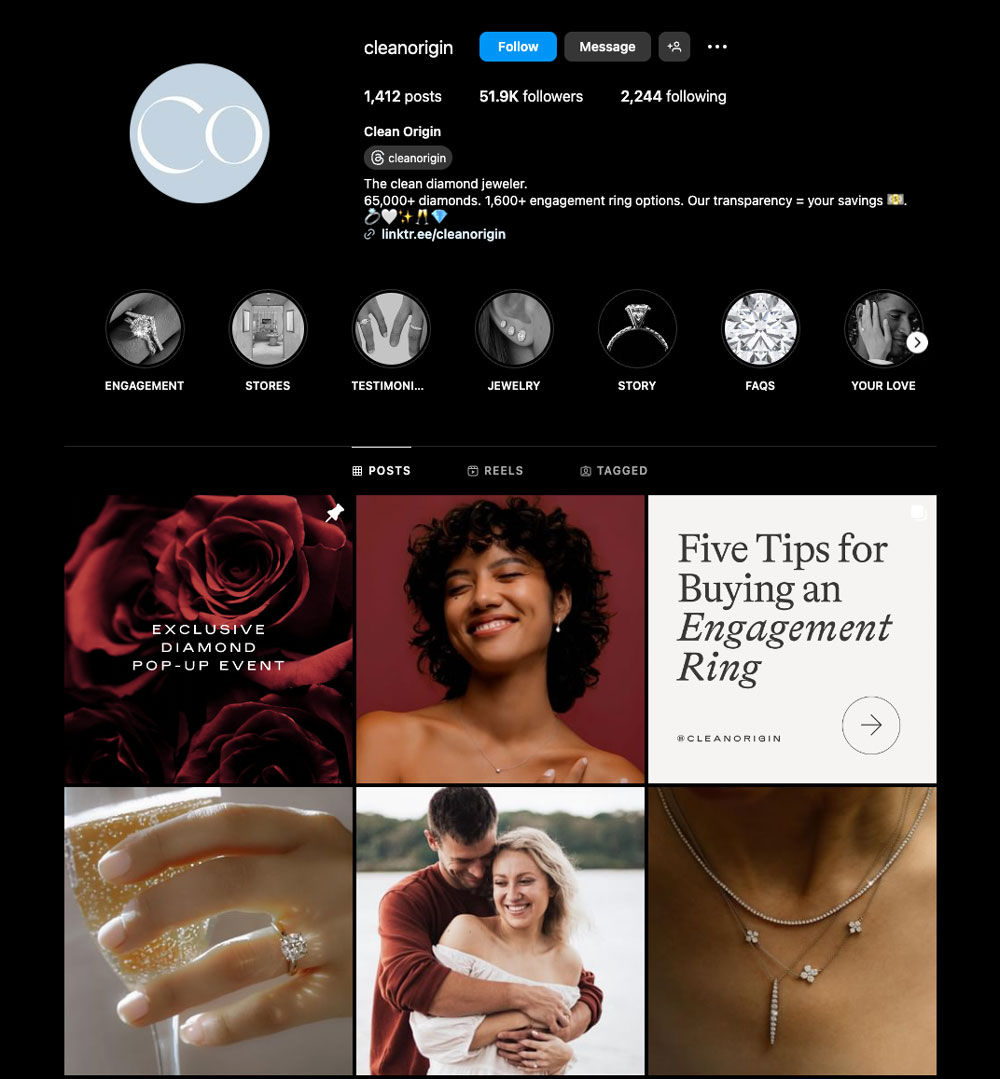
In contrast, their X (formerly Twitter) account, a more text-based platform, pales with less than 200 followers.
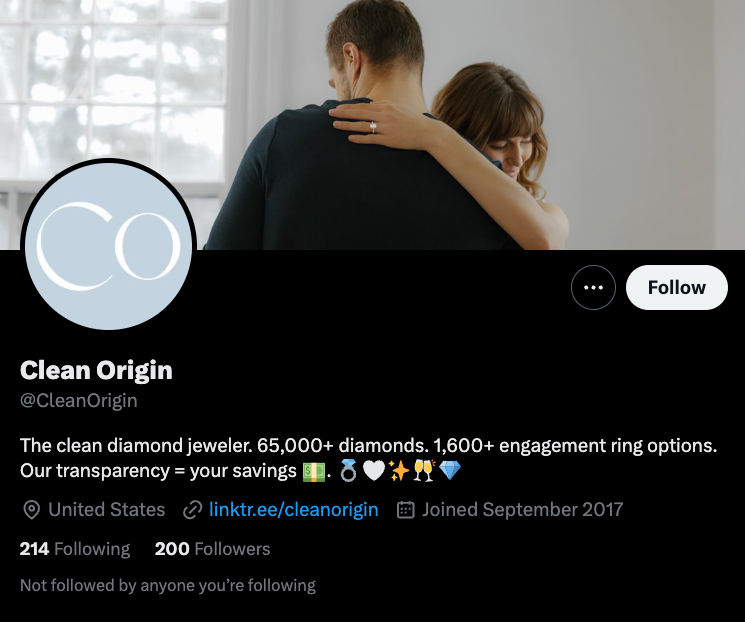
This stark difference underscores the importance of knowing where your audience prefers to engage. For Clean Origin, the visual feast offered by Instagram resonates more with its audience than the succinct posts of Twitter.
It’s a testament to the fact that understanding your audience’s preferences and habits can lead to more impactful and efficient marketing strategies.
Track Customer Interactions Down the Funnel
We live in an increasingly multi-device, multi-platform world. Customers no longer follow a linear path to conversion.
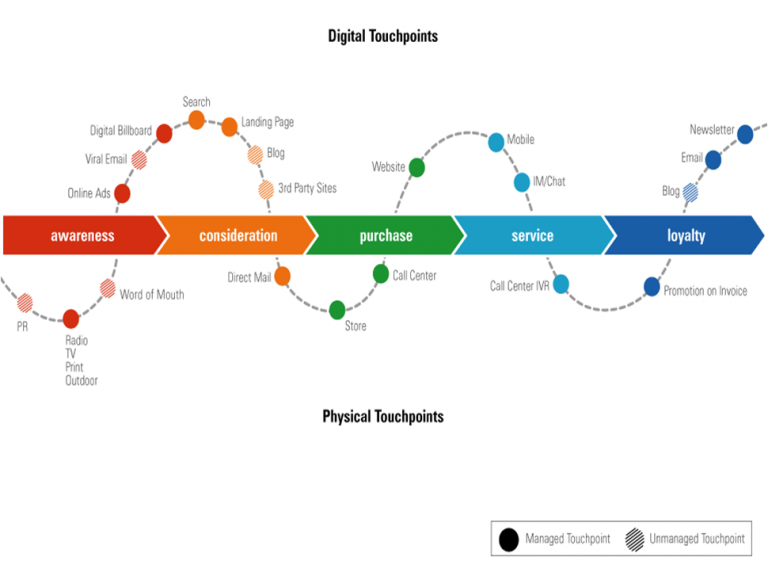
Instead, they interact with your brand across numerous touchpoints, making the journey more intricate. To truly grasp the effectiveness of your marketing efforts, it’s crucial to track these interactions down the funnel.
Enter Hims & Hers, a pioneer in telehealth and wellness products ranging from minoxidil (a hair loss treatment) to antidepressants. Their approach to cross-channel marketing attribution is both strategic and insightful.
By monitoring customer engagement across various platforms — including their website, social media, and other digital channels — they gain a 360-degree view of the customer journey. But why is this comprehensive tracking so crucial?
You can unlock a treasure trove of information to drive your decisions and set your campaigns up for success. Here are a few simple examples.
- Unlock a holistic understanding. Connect touchpoints to pinpoint pivotal channels and optimize resource allocation.
- Learn how to refine your strategies. Adapt efforts based on channel impact, like amplifying social media campaigns.
- Provide consistent messaging. Protect unified messages across platforms, enhancing trust and brand consistency.
- Enhance the customer experience. Tailor customer engagements from initial awareness to conversion for relevance and timeliness.
The key takeaway? Tracking interactions down the funnel is the perfect opportunity to collect customer data and turn that data into valuable insights.
For brands like Hims & Hers, it’s this deep understanding that drives success in their cross-channel marketing endeavours, turning every touchpoint into an opportunity for connection and conversion.
Set Up Custom URL Parameters
Cross-channel marketing attribution is a critical aspect of any successful marketing strategy, as it allows you to connect the dots and determine the true impact of your marketing efforts.
One effective way to achieve this is by employing custom URL parameters. But what exactly is it?
Have you ever clicked on a link and noticed a string of text at the end of the URL that seemed out of place? Something like “/source=social&campaign=summer_sale“? That’s a custom URL parameter in action.
Often known as an Urchin Tracking Module (UTM) parameter, a custom URL parameter is a unique tag that you add to your URL to track where your website’s traffic is coming from.
Think of it like attaching a digital name tag to your link, telling you who sent you the traffic and why.
You can then use it as a breadcrumb trail, helping you trace back to the origins of your user’s journey. With these parameters, you can:
- Learn which specific campaigns are driving the most conversions
- Understand the source of your traffic
- Make data-backed decisions
Take StudioSuits, for example, a brand renowned for its custom-fit suits for men. They employ a multi-faceted marketing approach, spreading the word about their latest products and styles across diverse channels, including email and social media.

To accurately track these touchpoints (and which ones are driving the most orders), they leverage custom URL parameters, such as the Source Identifier (SID).
This unique identifier empowers StudioSuits to distinguish between various sources of clicks and sales, providing invaluable insights into which channels are most effective. That way, they can double down on what channel is working and rework the ones that aren’t.
Stay Flexible When Challenges Arise
There are significant challenges to tracking multi-channel attribution. The most pressing issue is third-party data privacy. In recent years, advertisers have been restricted from collecting consumer data through third-party cookies.
In fact, Apple, Google, and Mozilla Firefox have discontinued these cookies. This means advertisers are limited in tracking consumer behaviour and activity across websites and platforms.
To adapt, you must focus heavily on collecting first and second-party data. In doing so, you can have critical insights about their behaviour that come straight from them.
Knowing the challenges in collecting third-party data is essential to creating a personalized cross-channel marketing campaign where you can follow your consumers down the funnel (no matter where they go).
So, what’s the secret recipe for pivoting in this ever-changing landscape?
The answer may lie closer to home. Platforms like customer relationship management (CRM) systems or email subscriptions can be goldmines.
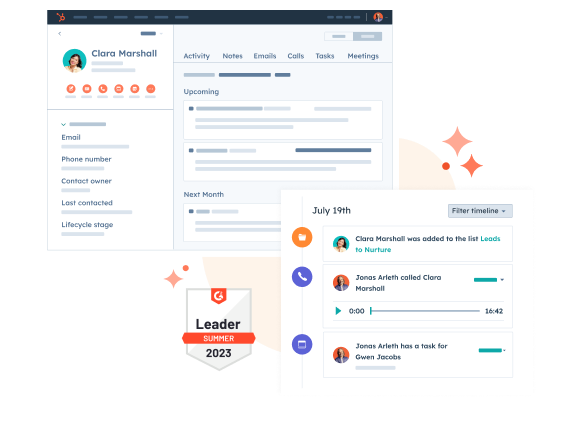
Why? They offer insights into your customer preferences, behaviours, and interactions directly from the source.
Encourage users to opt-in by offering value in return, whether personalized content, exclusive offers, or a seamless user experience. An informed and willing participant is invaluable in a privacy-centric world.
Identify Your Most Successful Marketing Channels
A major part of setting up a cross-channel marketing attribution strategy is figuring out which marketing channels are effective for your campaign. This is vital for determining your ROI and directing your marketing spend to channels that work.
The more marketing channels you have, the more difficult this becomes. Fortunately, analytic platforms like Google Analytics exist to provide data about each platform you’re using for marketing.
Google Analytics 4 is the new iteration of Google Analytics, designed to provide immersive metrics for all platforms. Google Analytics 4 can gauge web activity for desktop and mobile platforms.
This is great news if you have a mobile app and want to figure out how it connects with your web properties, like your website and social media profiles. Google Analytics offers a complete suite of data visualizations.
What’s more, you can use this data to accurately follow qualified leads from desktop to mobile devices and vice versa.
For example, let’s say you’re tracking leads across LinkedIn, a third-party affiliate, and your website.
With Google Analytics, you can find out if these variety of channels are bringing in traffic to make decisions on whether you need to adapt your cross-channel strategy to focus more on email marketing or pay-per-click ads.
Eliminate Unnecessary Marketing Channels
OK, we’ve touched on determining which marketing channels were conducive to campaign success. Part of this is also deciding which campaigns are completely unnecessary to your campaign.
For example, if you’re investing in Facebook and Google Ads, you can study both platforms to decide which isn’t worth investing in. You can also review your website analytics to find out if the leads from these platforms are resulting in conversions.
If you want to optimize your ad spend, it’s a wise strategy to cut back on unproductive campaigns draining your budget.
This will leave you more money and time to invest in those campaigns that are already performing well.
According to the latest statistics, companies make an average of $36 for every U.S. dollar they spend on email marketing, meaning—that’s one of the best channels for producing the highest ROI.
Nlyte, one of the more prominent B2B players on the software stage for DCIM, instead of going with the crowd (their competitors) and wasting thousands of dollars on paid advertising, figured out that email campaigns are bringing back home some of the highest quality leads for the least money invested.
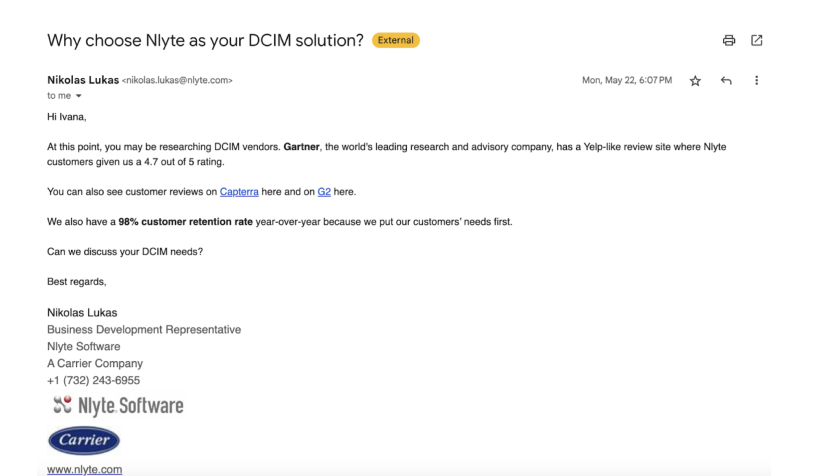
By doubling down on a proven channel that worked well for them (and removing the ones that fell flat), they’ve turned their email list into a main source of revenue.
How? By personalizing each email to speak directly to each of the recipients—that already fits their ideal customer segment.
Either by showing interest in their brand by subscribing to their email list themselves, or they have been prospected by the sales team and qualified as the ideal potential buyer.
Those leads eventually convert after being properly nurtured through their email campaigns.
And that’s just the tip of the iceberg. Since you own an email marketing list, it allows your marketing team to connect with customers throughout their journey, from initial interaction to loyalty and retention phases.
The result? A whole lot of happy customers. And happy customers love to spend more with your brand and spread the word to friends and family.
Refine Your Customer Journey
Using the data you collect from different campaigns, you can learn more about the journey your prospects are taking to engage with your brand.
Specifically, you can identify each touchpoint they’re making to make a purchase or drop out of the funnel entirely. For B2B brands, having an accurate customer journey is essential for maintaining a high conversion rate.
Therefore, you can collect data from Google Analytics to refine or rebuild your marketing funnel. In this sense, cross-channel marketing attribution can provide you with the data to rebuild your marketing campaign from the ground up.
So, imagine launching a new campaign that relies heavily on written content, like blog posts or e-books. Some of your target audience might not have the time to read, or they’re more auditory learners.
This is where taking a new approach, like integrating text-to-speech software, can be invaluable. By transforming your written content into audio, you provide an additional touchpoint that caters to a different segment of your audience.
This not only enhances user experience but also gives you another channel to track and attribute in your marketing mix.
By diversifying your content and paying attention to different consumption methods, you’re effectively connecting more dots, ensuring a clearer understanding of your marketing efforts and their impact on ROI.
Wrapping Up
There’s no doubt about it. Tracking cross-channel marketing attribution across websites and mobile apps is challenging.
However, it’s well worth the time and effort to master the art and science of this attribution. Why? You can learn how each marketing touchpoint sways your customers.
With the right tools in your tech stack, you can identify customer patterns and track your campaign’s ROI on a more granular level. Not sure where to start? We have your back at ClicData.
Here’s to your cross-channel marketing success thanks to a seamless experience!
Connect any data from anywhere. It’s that simple to level up your cross-channel marketing strategy.
Start your free trial today.
About the author
Joanne Camarce grows and strategizes B2B marketing and PR efforts. She loves slaying outreach campaigns and connecting with brands like G2, Wordstream, Process Street, and others. When she’s not wearing her marketing hat, you’ll find Joanne admiring Japanese music and art or just being a dog mom.

